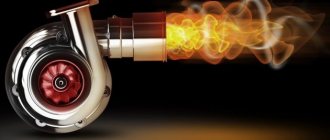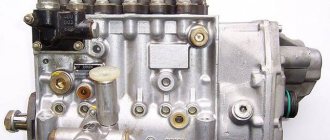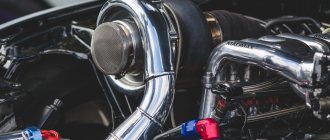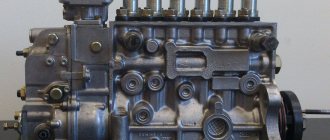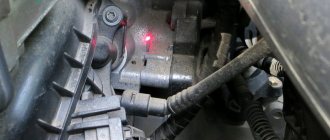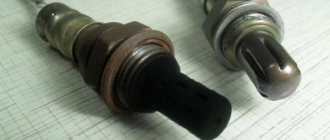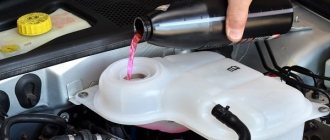A turbine is a complex power-injecting device. Unlike many other components of a modern car, its malfunction is not critical. However, it must be clarified that in this case there will be no normal operation, and the leakage of expensive oil and fuel will seriously hit the owner’s pocket. What signs of a diesel engine turbine malfunction can you detect on your own?
To begin with, it should be noted that the typical manifestations of a diesel turbine failure are very similar to the failure of other units and systems. Therefore, to accurately determine the cause of the appearance of a particular factor, it is necessary to carry out high-quality diagnostics using special stands and measuring instruments. An ordinary car enthusiast cannot do without contacting a service station.
Characteristic signs and possible causes
Often there is a combination of several obvious manifestations of a breakdown, but sometimes only one is observed. The malfunction can be determined by the following phenomena:
- increased oil consumption and leakage;
- change in color and visual increase in the amount of smoke;
- engine noise;
- temporary or permanent overheating;
- noticeable decrease in power and speed of acceleration;
- increased fuel consumption;
- increased emissions of harmful substances from the exhaust system and toxic odor;
- whistling or scratching in the turbine itself;
- floating idle.
The appearance of any of these items requires attention from the owner, prompt diagnosis and repair of the breakdown. The fact is that the lion's share of problems with diesel turbines, one way or another, relates to leakage and oil consumption. When it ends, the work surfaces will begin to wear off. To completely fail this mechanism, it is enough to work for just a few seconds without a lubricant. After this, restoration and repair will become impossible, all that remains is a complete replacement, and this is not cheap.
The tricks of supercharging and their display
A client contacted my workshop with a problem that, as he said, he had not been able to solve since purchasing the car for about six months. He has already studied this problem, since, according to him, he visited two services in Minsk. The bottom line was increased boost pressure. That is, the turbocharger pressure exceeded the norm, and the car fell into emergency operation. At the same time, the lights on the toolbar lit up: Check Engine, ESP, Service. And, accordingly, the car lost traction. The client also said that at one of these services, without finding any faults, the turbine was rejected. This turbine was removed and brought in for repairs. But the company that repairs turbochargers found no faults. And the turbine had to be put in place. I didn’t specify whether they took money for removal and installation or not, because if they didn’t, then I feel a little sorry for the people. Removing and installing it is still a lot of work. 4.7 standard hours are allotted for it. And since this is a Citroen C5, it is very difficult to meet this time. I didn’t imagine anything particularly difficult in solving the problem with supercharging. I have never encountered problems with supercharging on modern diesel engines. With only one caveat - SUPERCHARGING IS USUALLY NOT ENOUGH. Full of enthusiasm to figure everything out quickly, I put the car to work. Let's get started.
So, Citroen C5, 2.2 HDI, engine code 4HX.
I connect the scanner (Lexia) and erase the errors. Test drive. I accelerate as quickly as the slightly snowy road allows. First, second, third - the flight is normal. The turbine whistles. Acceleration is good. Everything is fine so far.
In fourth gear, around 90 km/h, everything that the client described happens. With the traction dropped and the lights on the panel burning, I return to the garage. I look at everything again with the scanner. Yes. There is an error in the engine ECU memory: P0245 “High pressure in the turbocharger.”
In this case, the following error appears in the entry:
— engine operating mode — 3373 rpm;
— turbocharger pressure — 2165 mbar;
— nominal pressure in the turbocharger (calculated) — 1835 mbar;
- cyclic ratio of turbine pressure solenoid valve opening - 4%.
So the boost pressure exceeded the calculated one by 330 mbar. Two errors were written into the ESP unit regarding problems with torque, which I decided not to pay attention to for now. I erase mistakes. And I look at the date at idle. I rev up to 3500 rpm. Yes, indeed, the calculated pressure is 1200-1300 mbar, and the actual pressure, according to the reading of the pressure sensor in the inlet pipes, is 1700 - 1800 mbar.
The control scanner displays as a percentage, literally, “the cyclic ratio of the opening of the turbine pressure solenoid valve.” At idle 53-55%, at 3500 rpm 5%.
True, no matter how much I accelerated at idle, the error did not appear. I connected a vacuum gauge to the boost control vacuum line (Fig. 1). Idling: -0.4 bar. Throttle: -0.1 - -0.05 bar. The controls seem to be working normally. Although the vacuum -0.4 bar, in my opinion, was too small. But there is still no data on this measurement. So let's not focus on this. I moved the car onto a lift.
I raised the car and removed the engine compartment protection. The turbocharger is located in a place that is extremely inaccessible even for inspection. I asked my friend to start the car and rev it up. Somehow I got used to seeing the turbocharger adjustment drive rod. When the engine was started, the vacuum drive rod retracted and at 3500 rpm it extended to its original position. Again, everything seems to be correct. I climbed the stepladder to the solenoid valve and removed the vacuum hose of the boost control drive. The rod came out. I drove off the lift and drove around with the vacuum hose disconnected. Same picture. I mean the appearance of errors and loss of traction. Once again on the scanner. With the vacuum disconnected, the boost pressure at 3500 rpm even increased to 1950-2050 mbar. A bit strange. But the conclusions, as they say, are obvious. Problem with the boost control mechanism in the turbine. What else could it be? Although I didn’t want to, it looks like I’ll have to remove the turbine and, most likely, take it for repairs. It was already Friday evening. And the withdrawal was accordingly postponed until Monday.
On Monday, before starting to dismantle this unit, I called Turbokom ODO. This call decided the course of all further actions. I talked with the engineer. A good and attentive person. Firstly, he enlightened me that this turbocharger is controlled differently than in a normal case. That is, when the rod is extended (no vacuum), the turbine spins to its maximum, creating maximum boost. And when the rod is retracted, accordingly, minimal boost is created. Secondly, control is carried out not by closing the bypass channel, but by changing the position of the blades in the volute. True, I knew about this “second thing”. But this “firstly” was a revelation for me, as it destroyed my ideas about the logic of French engineering. Was it really impossible to develop the CORRECT drive? I mean, logical. The vacuum is gone, the boost is gone. There is a vacuum, there is a boost. And so it turns out that if the vacuum is lost (this is often just a cracked hose), I accelerate to 4th without vacuum, the pressure of 2165 mbar tears my pipes and intercooler. While still accelerating at idle, I noticed that the pipes were swelling very strongly. That is, I think there is some kind of threat of breakdown due to overcharging. Otherwise the errors wouldn't appear. Or errors should appear at the very first gases. Let me remind you: the error did not appear at idle.
The engineer also advised me to check that the pressure sensor readings are correct, just in case.
I immediately checked it by connecting my pressure gauge to its air line (Fig. 2). Everything turned out to be fine here. The readings of the pressure gauge and sensor are almost identical.
I checked the boost at 3500 rpm by connecting the boost control vacuum hose to an external vacuum pump (my lungs). The pressure immediately dropped almost to atmospheric pressure.
New knowledge, of course, brought some clarity, but not completely, because the control of the boost solenoid valve now did not fit into what was happening. I checked again to see if it was the right valve. There are four identical Bosch valves 0928400414 (Fig. 3) on this engine. Moreover, three of them are located in one place on one bracket. No, the valve is 100% correct. Why such reverse control? Idle speed 55% and -0.4 bar, 3500 rpm 5% and 0.1 bar. Testing with an oscilloscope connected to the valve put everything in its place. The logic of PSA engineers is beyond competition. Try to guess how they describe 100% and 0% valve opening. Sorry, “cyclic valve opening ratio.” Normal people with basic knowledge of electrical engineering will answer unequivocally - there is power, full control (valve is open), 0% - no power, no control (valve closed).
For the engineers and programmers who wrote the Lexia dealer diagnostic program, it’s just the opposite. 100% - valve closed, off, no power. 0% - correspondingly, fully enabled. That is, when the ECU wants to relieve the boost pressure and, accordingly, based on new information, retract the rod (apply vacuum) - the “cyclic ratio” is 5%. But why does my vacuum not rise when the valve is open, but drops almost to zero? I found this problem in a couple of minutes without any tricks by disconnecting other valves from the vacuum line one by one. The culprit turned out to be the intake manifold geometry control valve (Fig. 4).
When the engine was cranked, it turned on to turn the valves, and due to a malfunction, it released all the vacuum from the system. It was disconnected from the vacuum line - and the problem was solved. At idle, the vacuum remained at about 0.4bag. When spinning up the engine, it first dropped to -0.2 - -0.15 bar (I assume, to speed up the turbine spin-up), then rose to -0.6 bar (decrease in boost pressure). The boost pressure began to correspond to the calculated one (Fig. 5).
During the test drive, the emergency mode was no longer activated. The problem with ESP has also disappeared.
The faulty Bosch valve 0928400309 will be replaced in the future. This issue has been agreed upon with the client.
Smoke color and exhaust smell
The appearance of smoke in the exhaust system immediately draws attention. This is often accompanied by an unpleasant chemical odor that can be heard even while driving.
Black smoke
This phenomenon means the combustion of the fuel mixture in the turbine. The problem is caused by a lack of air in the fuel system. Need to check:
- tightness of connections of all pipes;
- ECU;
- air filter (most often this is the cause);
- performance of the fuel system;
- engine.
Bluish-gray color
In this case, oil enters the engine. Obviously, the reason lies in the leak. It is necessary to inspect all connections, and the reason lies in problems with the turbine or engine.
Milky white color
Most often this happens when the oil drain line is clogged.
Signs and malfunctions of a turbocharger
- Blue exhaust smoke is a sign of combustion of oil in the engine cylinders, which got there from the turbocharger or engine. Black means there is an air leak, while white exhaust gas indicates a clogged turbocharger oil drain.
- The cause of the whistle is an air leak at the junction of the compressor outlet and the engine, and the grinding indicates the rubbing elements of the entire turbocharging system.
- It is also worth checking all the elements of the turbine on the engine if it turns off or stops working .
There are three reasons behind all turbocharger malfunctions
Lack and low oil pressure
Occurs due to leakage or pinching of oil hoses, as well as due to their improper installation to the turbine. Leads to increased wear of the rings, shaft journal, insufficient lubrication and overheating of the turbine radial bearings. They will have to be changed.
Oil contamination
This happens due to untimely replacement of the old oil or filter, water or fuel getting into the lubricant, or the use of low-quality oil. Leads to bearing wear, blockage of oil channels, and damage to the axle. Faulty parts should be replaced with new ones. Thick oil also harms bearings, as it produces sediment and reduces the tightness of the turbine.
Foreign object entering the turbocharger
Leads to damage to the compressor wheel blades (therefore, air pressure drops); turbine wheel blades; rotor. On the compressor side, you need to replace the filter and check the intake tract for leaks. On the turbine side, it is worth replacing the shaft and checking the intake manifold.
Structure of a car engine turbine: 1. compressor wheel; 2. bearing; 3. actuator; 4. oil supply fitting; 5. rotor; 6. cartridge; 7. hot snail; 8. cold snail.
Loss of power during acceleration, description of problems, removal of logs, diagnostics
To carry out the work, we need VAG-Com or another VAG diagnostic cable, for example VCDS.
For an initial assessment of engine operation, we take the log in blocks 3, 10, 11 at an engine temperature of at least 75 degrees, car acceleration
in 3rd gear up to 3000 rpm minimum.
As necessary, you can make and post logs of other blocks necessary for analysis.
Convenient program for graphical log processing DIESELPOWER LOG VIEW
You can download it here: https://vwts.ru/diag/dieselpower_logview_0_1_6.zip
Below you can read a brief description of problems in engine operation, what you should first pay attention to, what can be checked before performing diagnostics. And finally, a step-by-step description of diagnostics with a description and interpretation of the readings of some important channels.
For this information we thank a colleague from the vwts.ru forum under the nickname - moiPASSATtdi
. He offered his assistance in technical translation of information from Dutch:
If problems arise related to loss of power during acceleration, both constant and variable loss of traction while driving. Loss of traction in the “Slipper to the floor” mode or the engine goes into emergency mode (it drives, but does not pull or pulls weakly).
Read the entire text carefully, 9 out of 10 this will help you establish the exact cause of the problem.
1.
Pay attention to: A. Check the presence of the chip (Powerbox). If there is one, then disable it. B. Install a new air filter. B. Check the condition of the inlet air duct from the filter to the turbine, from the turbine to the intercooler (radiator-cooler for the air mass flowing under pressure from the turbine to the inlet manifold) for contamination or blockage. D. Also check the condition of the output manifold, except for the catalyst. * the catalyst may also be clogged with combustion products, and it is not surprising that there is a problem with loss of power. * the catalyst has a honeycomb system inside (meaning like bees) and their destruction leads to blockage and a problem associated with loss of power. D. High pressure fuel pump (HFP). Check that the injection angle is set correctly. If required, install correctly and drive. This angle check is carried out with VagCom at an engine temperature of 85 degrees. E. Injector. You also need to check the timing of the response in accordance with the position of the engine camshaft (Sensor G40 value). If you need to fix it, go to normal mode and drive.
2.
Connect VagCom to the car and diagnose. Erase existing errors, because they may already be outdated and do not require attention.
3.
Drive for a couple of days. Check the motor in different modes. It is also advisable to use the “sneaker to the floor” mode (full throttle). Have your car diagnosed again. Review the errors and save them to a file (print or rewrite). See if errors that were erased earlier still appear.
4.
Connect VagCom to your car. Go to Address 01 (Motor) and click on Measuring units 08. Take a log on channels 03 and 11. * Preferably channel 03 and 11 in one log. Because they influence each other. If you have VagCom registered and with one of the latest versions (from 704 and higher), then use the “TURBO” button for a more accurate measurement. * Remove logs two to three times to eliminate errors during recording. * Make graphs of log files.
5.
We will consider the logs for these two channels separately. First, turbine pressure. Then the readings from the mass air flow sensor (MAF). Because the turbine pressure will show us whether the engine ECU is in emergency mode (or there are other reasons). Attention: In emergency mode, the MAF readings are also underestimated. Therefore, some services mistakenly replace a completely serviceable sensor.
5a.
Channel 11 shows us the following about the turbine pressure status: If the incoming amount of air pressure (G71 Intake Air Pressure Sensor - DPVVG) is different than the requested pressure (More or Less), then this is very likely the cause of the problem. Attention: Low or high pressure can also be the reason the engine ECU goes into emergency mode. Also, unfortunately, it is impossible to determine in this log what the cause is (Air ducts, Valve No. 75, turbine, vacuum hoses.)
Carry out the check in the following order (in ascending order of cost):
1.
Check the condition of all hoses and air ducts between the turbine and the engine, pay attention to the presence of cracks, kinks and other damage. Also, connections must be sealed. It is advisable to rinse everything.
2.
Check the readings of DDVVG (G71) in the measurement blocks (Although it is strange, a damaged or defective sensor does not show an operating error). * Erase errors even if there is no longer an emergency mode, * Remove the log of groups 3 and 11 in different engine speed modes (but this time without “sneaker to the floor”, otherwise an emergency mode may occur again). * View the readings of the required (requested) amount of air pressure and the actual (actual) amount of air pressure (DDVVG (G71) prescribed readings and DDVVG (G71) actual readings). If the readings are in the normal range, then everything is fine. If constant, constantly low or high, then DDVVG (G71) is defective or broken.
3.
Valve No. 75: * View the readings of the operating cycle of Valve No. 75 in the recorded log (or log graph). The readings should be between 45% and 90%. If they are too high and more than 95%, then there is probably a problem with the turbine. * Test Valve No. 75 as follows: Connect the VagCom to the vehicle. Start the engine. Go to 01 – Engine, then 04 – Basic settings and open channel 11. The engine slightly raises idle speed. If everything is in order, then you will notice that the readings will change in a couple of seconds from 0% to 92%. Let the motor run for a while and see if the valve operates. You can help it work a little with your hands. In a good case, you will see that with each actuation, the turbocharger pressure value increases, which ultimately means positive operation. Check for vacuum in the tubes (in Basic settings - 04 channel 10). The engine must be started, otherwise there will be no vacuum. Follow the tubing to valve #75 and check the valve again. Check the vacuum (should be about 800 mbar) on the other tube of valve No. 75. One of the tubes has a constant vacuum, the other does not. The tube without vacuum goes to the air filter. If there is no vacuum in the tube going to the turbine, then valve No. 75 is faulty. For turbines with a bypass valve, the main culprit is valve No. 75 (The bypass valve is the pressure relief valve in the engine exhaust manifold). * Replace valve No. 75, it may not work stably and create problems only when the gas pedal is fully pressed. This is a normal valve that may not be fully open or closed. It seems to work, but not properly. The cost of replacing a valve is much lower than replacing a turbine. So start there.
4.
If you have a variable geometry turbine, then most likely the reason is soot deposits in the turbine.
Those. too much (errors 16618; 17965) or insufficient (errors 16619; 16683) incoming pressure from the turbine. Attention:
* Even if the rod moves to change the position of the turbine blades, the blades may be so dirty that they do not create enough pressure. * And also the shoulder blades can be locked in one position, thus creating a constantly high or constantly low pressure. Check the movement of the turbine blades as follows: Connect the VagCom to the car, start the engine. Go to 01-engine, then to 04-Basic settings and to channel 011. The idle speed will rise (essentially the procedure is the same as when checking valve No. 75). The blade movement regulator (a metal round boss on the turbine, with a vacuum hose suitable for it) will come under control. The rod on the regulator should move +/- 1.5 cm downward from the adjusting screw. If nothing happens, then try using a screwdriver or some thin rod to gently push the rod. It didn’t help and the rod remains standing in place or is jammed, then apparently the problem is related to the turbine. If the rod moves, then you should check the control tubes (in other words, the presence of vacuum using a vacuum gauge or using a finger). A. Clean the turbine and moving blades yourself. Run the test again. B. Take the turbine to a specialist for inspection. C. Replace the turbine (which will be a good blow to your wallet).
Is it possible to repair the turbine yourself?
The design of the turbocharger seems simple and straightforward. And all you need to repair a turbine is to know the turbine model, engine number, as well as the manufacturer and have spare parts or a factory repair kit for turbines on hand.
You can independently carry out visual diagnostics of the turbocharger, dismantle it, disassemble and replace defective turbine elements, and install them in place. Inspect the air, fuel, cooling and oil systems with which the turbine closely interacts, check their operation.
Preventing turbine breakdowns
To extend the life of your turbocharger, follow these simple rules:
- Change air filters promptly.
- Fill with original oil and high-quality fuel.
- Completely change the oil in the turbocharging system after every 7 thousand km .
- Monitor the boost pressure.
- Be sure to warm up a car with a diesel engine and turbocharger.
- After a long drive, allow the hot engine to cool down by idling for at least 3 minutes before turning it off. There will be no carbon residue that harms the bearings.
- Carry out regular diagnostics and ensure professional maintenance.
Turbocharged engines are rapidly gaining popularity. If previously turbochargers were installed in heavy or powerful sports cars, now turbines can be seen in passenger cars, both with a gasoline engine and a diesel one.
Diesel engine turbines usually have a service life much shorter than that of the engine itself. In order to carry out preventive maintenance on time and not face the need to pay for expensive parts, you need to periodically check the operation of the turbine. This can be done independently, without contacting a car service.
How does the turbocharger sensor work?
The boost pressure sensor is installed directly between the turbocharger and the intake manifold. It serves to monitor the boost pressure and, based on its readings, the electronic control unit draws conclusions about the needs of the power unit for forced air.
Turbo boost sensor
Today, the production of these sensors is carried out using two technologies: micromechanical and thick film. The first is the most perfect and progressive. Most of these devices today are built using this technology. The main elements in this case are a chip made of silicon, a diaphragm, and four strain gauges located directly on it. When pressure is applied to this diaphragm, it bends. Due to its mechanical stretching, strain gauges begin to change their resistance. The voltage changes proportionally to it. For greater sensitivity, thermistors are connected to each other using a special bridge circuit. The chip's circuitry increases the bridge voltage, which outputs between one and five volts. By analyzing the magnitude of this voltage, the electronic engine control unit estimates the pressure in the intake manifold. The higher the voltage, the higher the air pressure.
If the engine is not running, then the pressure in the intake manifold is equal to the atmospheric pressure. When the power unit starts, a vacuum or vacuum is formed in the intake manifold. When the engine is running with the throttle valve open, the pressure in the intake manifold begins to compare with atmospheric pressure.
Failure of the sensor can lead to turbocharging shutdown. However, to accurately make a correct diagnosis, it is necessary to conduct a competent diagnosis. It is quite possible that it is not the sensor that is faulty, but the turbine itself. In this case, it will need to be replaced.
Checking the turbocharger sensor
Turbocharged power units must be equipped with a special sensor that monitors deviations in boost pressure. In order to limit this pressure at the right time, the electronic engine control unit actuates a special solenoid valve that is capable of establishing a vacuum.
Controlling turbine boost pressure deviation is very similar to controlling exhaust gas recirculation deviation. If the boost pressure goes beyond certain limits for quite a long time, this may indicate that there is a high probability of malfunction in the turbocharging system. If these deviations are of a fairly short duration, then the presence of a malfunction is unlikely.
Boost pressure must be monitored on absolutely all turbocharged engines, since this indicator affects the correct filling of the cylinders, as well as the developed power, torque and the chemical composition of the exhaust gases. The accuracy of the boost pressure sensor readings is checked with the power unit not running at the moment between turning on the ignition and starting the engine. During the check, the values obtained from the turbine boost pressure sensor and the atmospheric pressure sensor are compared. As a result of comparing these indicators, the so-called differential pressure is obtained, which normally should not exceed a certain limit. If this limit is not exceeded, then the boost pressure sensor can be considered fully operational.
Causes of malfunction
In order to inspect the turbine and identify a malfunction, it is necessary to understand what kind of breakdowns can occur in the turbocharger system.
Usually the most problematic elements are seals and bearings. Wear of these parts may cause backlash, noise, and you may encounter a turbine wedge. Operation may be disrupted due to a malfunction of the lubrication system, ventilation valves, or the piston rings are already sufficiently worn out. In this case, diesel fuel combustion products enter the crankcase and lead to negative consequences.
If smoke is noticed in the exhaust, most often blue, then you should pay attention to the PCV valve. Its incorrect operation increases the oil pressure in the turbine, which causes the lubricant to press through the seals. Once outside or into the forced air, the oil changes the composition of the mixture, causing the engine to significantly lose power and begin to emit the aforementioned smoke.
Gorky - “steyr”
GORKY - "STEIR"
Until now, in Russia passenger diesel engines are viewed with distrust. There are several reasons. Here are the unstable quality of fuel, especially in rural areas, the unpreparedness of domestic service to service complex diesel equipment, the high price of spare parts and noise and vibrations that are supposedly organically characteristic of a diesel engine.
Few diesel cars are imported from abroad, and the production of our own is simply a disaster. Therefore, the Gorky Automobile Plant, which produced about 8,000 diesel engines under Austrian license, turned out to be a kind of national record holder. The GAZ-560 engine successfully fits under the hood of Nizhny Novgorod cars. The Volga's diesel fuel consumption is about 8 liters, and the Gazelle's is about 12 l/100 km. The diesel produces noise and vibration only at idle, and already at a speed of over 50 km/h, few will be able to determine the type of engine from the interior.
One of the features of a diesel engine is that it cannot be warmed up at low loads and at idle speed. In winter, when parked in a twenty-degree frost, it does not rise above 40–50°C, which is why it is cool in the car. However, when driving, the interior heating is no worse than with a gasoline engine. If a diesel engine starts normally after being parked in the cold, it will not stop due to frozen fuel: the channels for supplying and discharging fuel from the pump injectors run in the monoblock next to the cooling jacket. After some time, the “return” with a flow rate of up to 100 l/h heats the tank to above-zero temperature. If the battery and glow plugs are in good condition, the fuel in the tank is winter, then with 5W40 oil, starting up to minus 30°C is not a problem. Even colder? You will have to additionally insulate the engine compartment to prevent the crankcase ventilation oil separator from freezing. Otherwise, the oil will be squeezed out through the cuffs, dipstick, oil filler neck and turbocharger.
Having spent money on a diesel engine, it is a sin to skimp on the quality of fuel and oil. At dubious gas stations, instead of diesel fuel, they may also sell boiler and furnace fuel - at first glance you cannot tell it apart. What then can we say about the cetane number, flash point, osmolality and other important characteristics! Delayed ignition and late combustion lead to local overheating and cracking of the combustion chamber in the piston. Meanwhile, the cetane number is no less important for a diesel engine than the octane number for a gasoline engine. If not more! After all, low-octane gasoline reveals itself immediately - with detonation knocks, and people sometimes find out about the low quality of diesel fuel with a delay. The resin, settling on a tiny mesh that protects the precision plunger pairs of pump injectors from dirt, creates additional resistance for filling them with fuel. Because of this, the pressure at the injector outlet decreases, fuel atomization deteriorates, and the plunger pair wears out.
The first sign of such wear is difficulty starting a hot engine. In a good way, the injectors then need to be changed. However, they are expensive, about 6200 rubles. (photo 1). And this operation is more complicated than replacing spark plugs. Therefore, if a cold engine starts well and there are no serious problems with its power and efficiency, the life of the injectors can be extended by another 20–30 thousand km. To do this, we simply “deceive” the control program. Starting a cold and hot engine occurs according to different algorithms in the memory of the control unit. They start it cold, increasing the cyclic fuel supply by 3–4 times. To start a hot engine with worn injectors, you can use the “cold” settings. To do this, remove the terminals from the coolant temperature (photo 2) and air temperature (photo 3) sensors. Now the block calculates cyclic feeds as for 20-degree frost. If the engine starts normally, you can make this deception permanent by connecting the wires from the sensors to a toggle switch. But nothing lasts forever: in an engine with worn injectors, fuel consumption will eventually begin to increase, power will drop, and replacement with new ones will become inevitable.
The breakdown of one pump injector is immediately noticeable - due to uneven operation of the engine at idle. It's easy to identify the faulty one. Having started the cold engine, in the first seconds we feel the exhaust manifold pipes - an idle one is colder. When it's warm, it's hot everywhere, so this technique will cause more burns than it's worth. There is no urgent need for replacement while on the road. With a faulty injector, you can drive a couple of hundred kilometers without harm to the engine, but you should not overload it. It is better to drive in lower gears, maintaining the speed at 3000 rpm.
When the engine is running, fuel is constantly driven through the pump injector at a pressure of about 1.5 bar, which not only well fills the space above the plunger, but also cools the injector. The booster pump is responsible for this - it is next to the tank (photo 4). If this pump fails, the diesel engine continues to work somehow; fuel is supplied to the injector due to the vacuum created when the plunger moves upward (suction). But this is not enough for normal engine operation. Lack of fuel causes wear of the plunger pair. After driving 100–150 km in this mode, get ready to replace all pump injectors.
When to check the turbine
If you use high-quality oil and treat the diesel unit with care, the turbocharger will operate properly for approximately 150 thousand kilometers. To detect any breakdown at its initial stage, you need to carefully monitor the turbine; just check the operation of the unit during an oil change.
Thus, the car owner can save significantly by repairing the problem at its initial stage, instead of replacing an expensive part.
First signs of trouble
Of course, if a car enthusiast does not have experience working with cars, you should not immediately disassemble the unit and try to identify the fault from the inside. There are several signs that indicate the turbocharger is not working properly:
- the appearance of bluish or black smoke during exhaust;
- very loud operation of the diesel unit under various loads;
- the engine often overheats;
- fuel consumption is steadily increasing, as is the rate of oil consumption;
- deterioration of traction, loss of power and dynamics.
Self check
The initial check can be carried out on your own, so as not to spend money on computer diagnostics, which often costs a lot of money. First, the turbocharger needs to be carefully inspected.
First of all, the level and quality of the engine oil used for the diesel engine is checked. Then you need to make sure that no foreign object has entered the compressor.
After the procedures are completed, it is necessary to evaluate the color of the exhaust. It can also point out specific problems with the turbine. If the exhaust color is black and a drop in power is noticed, then most likely you will have to deal with an over-enriched mixture. It appears due to a breakdown of the air intake-exhaust system. At the intake, insufficient air enters the cylinders, and at the exhaust there may be leaks, which lead to loss of power.
Blue or even white smoke from the exhaust pipe indicates that oil enters the cylinders and then burns in the working chamber. In this case, oil consumption can increase to about a liter per 1000 kilometers. It is necessary to check the operation of the rotor and the cleanliness of the filters. The rotor must have slight play and not touch the housing, otherwise the part requires immediate inspection and repair.
A heavily contaminated filter cannot pass the required amount of air, which creates different pressures in the turbocharger housing and in the cartridge with bearings. From this cartridge the oil enters the compressor. If the problem is not in the filter, then you need to check the entire oil supply system, hoses and pipes for bends, cracks and crevices.
The tightness of the pipe connections can be checked with the engine running. Whistling and creaking, as well as air breaking through the system, indicate that the clamps need to be tightened. Any leak or damage will result in insufficient air supply to the cylinders.
Another cause of turbine malfunction is improper oil drainage due to gases entering the crankcase. It is necessary to check the ventilation system so that the diesel engine does not start to breathe.
How to check a diesel engine turbine? Diagnosing faults at home
Once upon a time, turbocharged power units could be found exclusively on heavy-duty vehicles; a little later, racing cars also began to be equipped with turbines. Today, turbocharged engines “feel great” in ordinary cars. The development of the turbocharged line of engines is so rapid that conventional aspirated engines (a naturally aspirated internal combustion engine or internal combustion engine) simply have no choice but to give way to more advanced and powerful “brothers”.
More horses, more power, this is, of course, good, the bad thing is that, unfortunately, there are more problems with engines equipped with a turbine. Despite advances in the automotive industry and innovative technologies, modern turbo engines are not without drawbacks; they are just as vulnerable as conventional engines, and in some cases even more so.
Today in the “How to check” section we will talk about turbines, their malfunctions, and also how to check a diesel engine turbine at home.
First, what is a turbine?
Almost all modern turbocharged engines are built on the same principle, they are easy to install, have a compact size and are quite simple to install. Turbines are predominantly snail-shaped, and their air channels at the outlet are narrowed, due to this the pressure increases, as well as the speed of rotation of the turbine. The body is made of cast iron or aluminum alloy.
How does a turbocharger work?
Exhaust gases from the exhaust manifold enter the air channels, moving at high speed, this creates pressure on the petals, which rotate and unwind the rotor. In turn, the rotor spins the turbocharger impeller, which sucks in air and then feeds it into the combustion chamber.
From school, each of us knows that combustion requires air, therefore, the more air there is, the stronger the combustion will be. Under high pressure due to air injection, as well as exhaust gases, the turbine becomes seriously hot and therefore needs cooling. The solution to this problem was the invention of the intercooler, which is something like a radiator for the cooling system.
To operate, the turbine uses a lubrication system that comes from the engine through a special circuit. In addition to its lubricating properties, oil also acts as a coolant.
Turbocharger malfunctions - how to understand that the turbine is faulty?
Signs of a turbine malfunction:
- The car does not pull, there is a significant deterioration in dynamics;
- The engine does not gain momentum for a long time;
- Smoke from the exhaust is bluish or gray in color;
- Characteristic smell of burnt oil;
- The engine takes oil;
- Extraneous noises coming from under the hood: howling, whistling, hum, etc.;
- Unstable engine idle speed.
- , the turbine must be checked at a service station using special equipment; the air pressure sensor is checked first. Often the cause of a faulty turbine lies in this sensor. Using a special connector, a diagnostic device is connected, after which information about the operation of the sensor is read.
- The second step is to check the output from the turbocharger, connect a special device with a pressure gauge to it, then take measurements. Based on the measurement results, the technician makes a conclusion about the serviceability or malfunction of the diesel engine turbine.
If it is not possible to check the turbine at a service center, you can independently check the turbine in a garage, that is, with your own hands.
1. The very first thing that needs to be done in the event of an inspection is to perform a visual inspection of the turbine and the “around the turbine” space. Take a closer look at the color of the smoke; its color should not have bluish, black or bluish tints.
- White smoke from the exhaust may indicate clogged air passages or an oil drain line. As a rule, in this case the engine begins to “take” oil.
- Black smoke that looks like soot may indicate a possible leak in the air supply system.
- Blue smoke is usually a sign of an oil leak in the turbine. Most likely, oil enters the combustion chamber, resulting in coloration of the exhaust. To confirm or refute the assumption, remove the air filter; if there is oil on its surface, then the assumption is correct, but if the filter is in order, most likely the reason is different.
2. Next, you need to warm up the engine and carry out the second stage of checking the turbocharged engine . To complete this check you will need "help from a friend". On your car's engine, you need to find the pipe that goes from the turbine to the engine intake manifold.
Pinch it with your hand and ask an assistant to sharply press the gas pedal and hold it in this position for about 3-4 seconds. Then give the command to also sharply release the pedal, while holding the pipe, you will feel how it begins to swell due to strong air pressure. Perform several such cycles, then pressing and then releasing the gas pedal.
If during the test the pipe does not inflate, you can safely conclude that the turbine is faulty .
3. Carry out a thorough inspection of the turbocharger itself; it should not be covered in oil or any other stains. Disconnect the pipe connecting the turbine and the intake manifold, make sure that there are no traces of oil in it, it must be completely dry. If leaks or outright oil accumulations are detected, it can be assumed that the turbine of your diesel engine has failed or, more simply put, “died”.
Question Auto
Source: https://vopros-avto.ru/kak-proverit-turbinu-dizelnogo-dvigatelya-diagnostika-neispravnostey-v-domashnih-usloviyah/
Checking with the engine running
The easiest way to check a turbine on a diesel engine requires the presence of at least two people.
- Start the engine.
- Locate the pipe between the turbocharger and the intake manifold.
- Pass it on.
- Press the gas for a few seconds.
When the turbine is operating correctly, you will feel that the pipe is noticeably inflated. If this does not happen, various cracks and defects in the collector are possible. You should seek qualified help to troubleshoot the problem.
It is very important to understand that you can carry out diagnostics yourself, but repairs must be entrusted to professionals.
Unqualified intervention can lead to the fact that a small malfunction will lead to the breakdown of the entire part and put the car owner in front of the need to change and repair the turbocharger. It is necessary to contact a trusted service center, where specialists will quickly and efficiently eliminate the malfunction and extend the life of the turbocharger on a diesel engine.
How to check a diesel engine turbine
Turbocharged engines appeared relatively recently, but their evolution is so rapid that they are slowly displacing their “brothers” that lack this useful and popular system called turbocharging.
Unfortunately, more power does not mean less problems, I would say, on the contrary. Modern turbo engines, although brought to perfection, still have a lot of shortcomings and are just as vulnerable as simple “aspirated” ones. In this article I will talk about what a turbo engine is , the most common “sores” of turbocharged engines, as well as how to recognize and diagnose a malfunction of a turbocharged engine.
First, a few words about what a turbine is and how it works
Almost all turbocharged engines have the same principle. The first turbochargers were installed exclusively on heavy-duty vehicles, as well as on racing cars at the beginning of the last century. As you understand, at that time the weight and design of the turbines left much to be desired, which cannot be said about modern examples.
The new generation of turbochargers are compact and easy to install, and their efficiency is many times higher than their predecessors.
But, like everything in this world, one fine day the turbocharger begins to act up, the engine loses its former power and performance, and as a result you have a new headache.
Almost all turbines have a snail-shaped casing. The air channels of the housing become narrower at the outlet, which increases pressure and rotation speed. Exhaust gases move through the air channels and come from the exhaust manifold.
Moving through the channels, they gain high speed and act on the petals, which, rotating under the pressure of the exhaust gases, spin the rotor. The rotor, rotating, spins the turbocharger impeller, which pumps air and supplies it to the combustion chamber under high pressure.
And as you know from your school physics course, the more air, the stronger the combustion.
Due to the high pressure that is created when air is pumped, the turbine needs cooling; the intercooler plays the role of a radiator for the turbine. The turbine uses an engine lubrication system, which is supplied through a special circuit. Oil, in addition to lubrication, cools the turbine.
Now that we have figured out what a turbine is and how it works, I propose to consider the main signs of a turbocharger malfunction .
Signs of a faulty turbine:
- Poor traction, deterioration of dynamics;
- The engine takes a long time to gain speed;
- Bluish or gray smoke from the exhaust;
- The appearance of a characteristic smell of burnt oil;
- Oil waste;
- Whistling or other noise from under the hood;
- Floating idle speed.
How to check a diesel engine turbine?
The check is carried out using special equipment; first of all, the air pressure sensor, which is supplied to the manifold, is checked, since very often the reason lies precisely in it. The turbine is usually checked at a service station. A diagnostic device is connected to a special connector and information about the operation of the sensor is read.
The second place that requires special attention in the event of a turbine failure is the outlet of the turbocharger. A special device equipped with a pressure gauge is connected to this output, after which measurements are taken. Based on the measurement results, a conclusion is made about the condition of the turbine.
How to check a turbine on a diesel engine at home?
If you do not have the time or desire to go to a service center to diagnose the turbocharger, you can try to check the turbine yourself.
- The first step is to carry out a visual inspection. Pay attention to the color of the smoke; it should not be blue, black or gray. If white smoke comes out of the exhaust, it can be assumed that the air passages or oil drain line are clogged. In this case, the engine will begin to “eat” oil. Black smoke or soot may indicate a leak in the air supply system. Blue smoke may indicate an oil leak in the turbine, most likely penetrating into the combustion chamber(s) of the engine. To check if this is the case, remove the air filter and check for oil on its surface.
- The second point is to check the turbocharged engine after preheating. An assistant will be required for this check. Find the pipe leading from the turbine to the engine intake manifold, then try to pinch it with your hand. At this time, the assistant must sharply press the gas and hold the pedal in this position for about 3 seconds. After this, he must also abruptly release the pedal. In the meantime, holding onto the pipe, you should feel how it begins to swell from high air pressure. Do several such cycles, sharply pressing and then releasing the gas pedal. If the pipe does not inflate, there is a problem with the turbine, if on the contrary, the turbine is most likely fully operational.
- Carefully inspect the turbocharger ; there should be no traces of oil, soot or leaks. Disconnect the pipe that connects the intake manifold and the turbine, check for traces of oil, it should be completely dry. If you find traces of oil, most likely the turbine has “died”.
Apr 19, 2015KoGa
Source: https://www.ford-motors.ru/kak-proverit-turbinu-dizelnogo-dvigatelya.html
